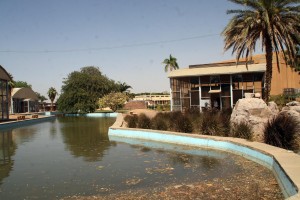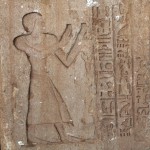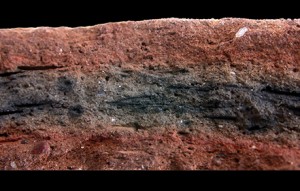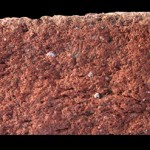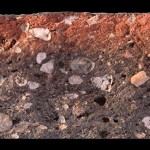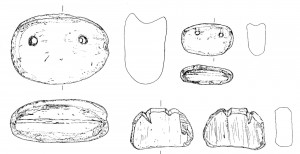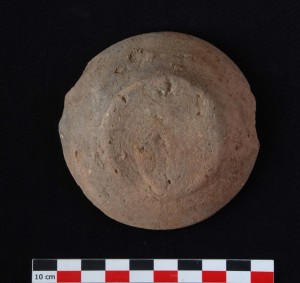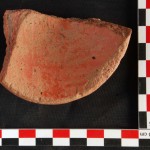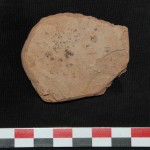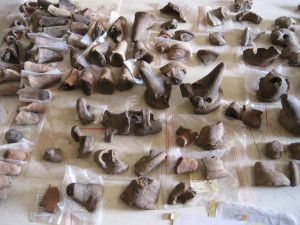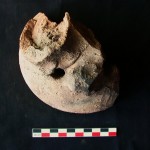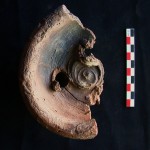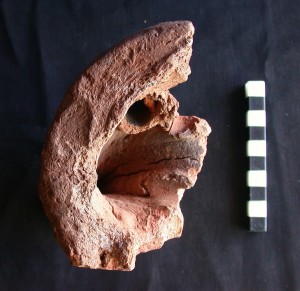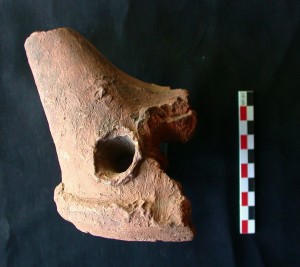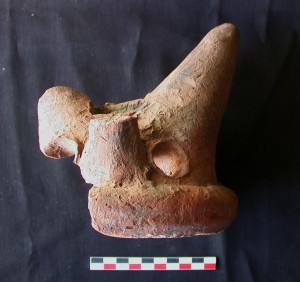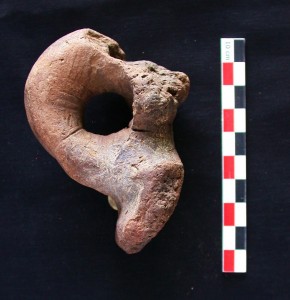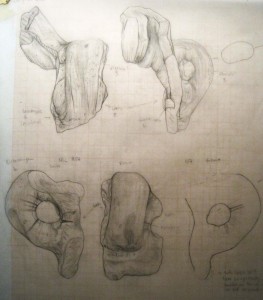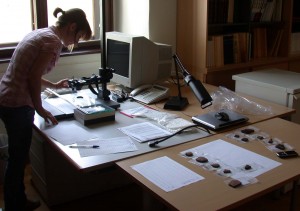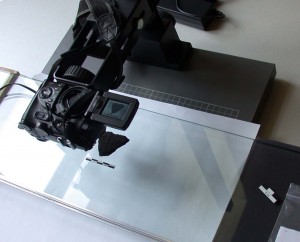Last week, some of the Aegean imports found on Sai Island in contexts of the 18th Dynasty were mentioned. Today, I would like to present a so far unique piece from SAV1 North.
It is the lower part of a decorated rhyton, covered in a red slip and burnished, made in a very fine Nile B (SAV1N N/C 1205). The conical vessel shape is characteristically Aegean; it is an Egyptian imitation of a Late Minoan IA rhyton, known from other sites in Egypt (especially finds from Tell el-Daba/Ezbet Helmi, see Hein 2013: fig. 6; cf. also Egyptian faience versions of Aegean rhyta, Vermeule 1982). Rhyta are attested in various shapes and types, but as a rule they have a secondary opening apart from the mouth. This also holds true for N/C 1205 which was perforated at its base.
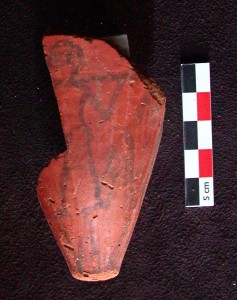
The fragment of an Egyptian imitation of an Aegean rhyton from Sai
The area around the perforated bottom of N/C 1205 is painted in black with floral elements. Just above these lotus flowers a register with figural painting is still partly visible. It seems to be a scene in the marshes: a striding male figure is carrying two fishes hanging from a pole set on his shoulder. This motif finds a close parallel in one of the silver vessels from the famous Bubastis hoard, characterised by a mixture of Near Eastern and Egyptian styles and motifs (see Bakr/Brandl 2010). Further parallels can be named from the tomb decoration of Egyptian private tombs, especially of the Middle Kingdom and the 18th Dynasty at Thebes.
What may be the function of such an extraordinary vessel in the New Kingdom town of Sai? Similar as the precious metal vessels from Bubastis, also pottery rhyta like N/C 1205 probably had the character of luxury items (cf. Hein 2013). Furthermore, the Egyptian “fish” motif as part of a little marsh scene might be interpreted as a symbol of renewal (cf. Minault-Gout 2004: 120; Stevens 2006: 55-56, 180). Such a general sphere of creation is also evoked by a small pottery figure vase in the form of a fish, a tilapia nilotica, which was discovered in one of the 18th Dynasty tombs at Sai (Minault-Gout 2004: 120; Minault-Gout/Thill 2012: 55-67, tomb 8, no. 87, pl. 160). This remarkable zoomorphic vessel (Khartoum SNM 31319) is, like N/C 1205, a fine red slipped and burnished Nile clay, decorated with black paint. Figure vessels of this type are rare, but another example was found in Upper Nubia at Soleb (see Bourriau 1982: 103-104, no. 86.)
All in all, the Egyptian rhyton from Sai Island illustrates not only the international age of 18th Dynasty Egypt and contacts to the Aegean, but it also refers to important aspects of daily life like creation and fertility.
References
Bakr/Brandl 2010 = M. I. Bakr/H. Brandl, Precious metal hoards from Bubastis, in M.I. Bakr/H. Brandl with F. Kalloniatis (eds.), Egyptian Antiquities from Kufur Nigm and Bubastis, Berlin, 2010, 43-53.
Bourriau 1982 = J. Bourriau, No. 86: Fish vase, in E. Brovarski/S.K. Doll/R.E. Freed (eds.), Egypt’s Golden Age: The Art of Living in the New Kingdom, exhibition catalogue, Museum of Fine Arts Boston, 103-104.
Hein 2013 = I. Hein, Cypriot and Aegean features in New Kingdom Egypt: cultural elements interpreted from archaeological finds, in P. Kousoulis/N. Lazaridis (eds.), Tenth International Congress of Egyptologists, University of the Aegean, Department of Mediterranean Studies, Rhodes 22-29 May 2008 (Orientalia Lovaniensia Analecta), Leuven, 2013 [in press].
Minault-Gout 2004 = A. Minault-Gout, Cat. 95: Figure vase in the form [of] a fish, in D.A. Welsby/J.R. Anderson (eds.), Sudan. Ancient Treasures. An Exhibition of recent discoveries from the Sudan National Museum, London, 2004, 120.
Minault-Gout/Thill 2012 = A. Minault-Gout/F.Thill, Saï II. Le cimetière des tombes hypogées du Nouvel Empire (SAC5) (FIFAO 69), Cairo, 2012.
Stevens 2006 = A. Stevens, Private Religion at Amarna (British Archaeological Reports, International Series 1587), Oxford, 2006.
Vermeule 1982 = E.T. Vermeule, Egyptian Imitations of Aegean Vases, in E. Brovarski/S.K. Doll/R.E. Freed (eds.), Egypt’s Golden Age: The Art of Living in the New Kingdom, exhibition catalogue, Museum of Fine Arts Boston, 152-153.
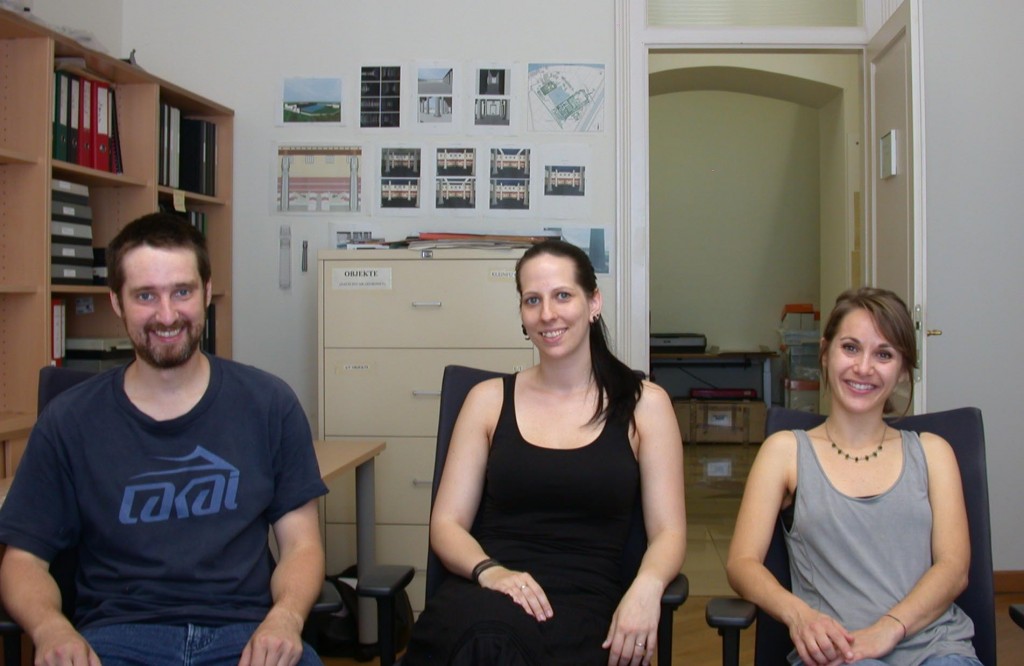 This week it is unusually hot in our office and also quite crowed: due to a nice coincidence we’re getting additional help in documenting our sample sherds by an experienced young scholar! Arvi Korhonen, MA student at Humboldt University Berlin and long-time student assistant there who has worked since 2008 with Julia Budka in Egypt (Elephantine and Asasif), is staying in Vienna over the summer – and will strengthen AcrossBorders on a temporary basis! Hopefully Arvi will also join us for the upcoming field season at Elephantine in winter 2013, concentrating on documenting pottery of the 18th Dynasty!
This week it is unusually hot in our office and also quite crowed: due to a nice coincidence we’re getting additional help in documenting our sample sherds by an experienced young scholar! Arvi Korhonen, MA student at Humboldt University Berlin and long-time student assistant there who has worked since 2008 with Julia Budka in Egypt (Elephantine and Asasif), is staying in Vienna over the summer – and will strengthen AcrossBorders on a temporary basis! Hopefully Arvi will also join us for the upcoming field season at Elephantine in winter 2013, concentrating on documenting pottery of the 18th Dynasty! Prior than submitting our samples for analysis and thin sections, we document the diagnostic pieces in detail by 1:1 pencil drawings. Arvi started with it this week and was feeling much at home – not only because of the “Egyptian” temperature in the Postgasse, but especially as so many forms and wares are well known to him from Elephantine. This holds especially true for the Marl clay vessels, but also the Nile clay forms are very comparable and differ only in small details of the fabric, surface treatment and production technique.
Prior than submitting our samples for analysis and thin sections, we document the diagnostic pieces in detail by 1:1 pencil drawings. Arvi started with it this week and was feeling much at home – not only because of the “Egyptian” temperature in the Postgasse, but especially as so many forms and wares are well known to him from Elephantine. This holds especially true for the Marl clay vessels, but also the Nile clay forms are very comparable and differ only in small details of the fabric, surface treatment and production technique.
